
Software Defined Radio Radiometer
Implementation and Evaluation of a Software Defined Radio Radiometer
My Master’s work in Computer Engineering did research in implementation of a software defined radio radiometer. The approach was to digitize as early as possible and instead of just digitizing total power readings, keep both phase and amplitude information. This requires more processing, but the advantage is more flexibility in the radiometer and additional capabilities such as filtering out unwanted interference. Additional information can be found in my thesis or my GitHub repository. My thesis explains both the theory and the experiments I ran to test the theory of mitigating interference. The GitHub repository also has a copy of my thesis as well as the code that was used on the SDR and used to analyze the data.
CAD drawing view of CySat-1
Since completing this work, the concept shown in my thesis is now a payload that will be going up on CySat-1. CySat-1 is Iowa State University’s first Cubesat mission. It is a 3U satellite that is expected to be launched in Spring of 2021. The satellite was designed and built by my students working in my lab and part of the program I run called Make to Innovate. The students designed and built the structure used for the satellite. The Electronic Power System (EPS), the Attitude Determination and Control System (ADCS), the Flight Computer and the UHF transceiver were all purchased off the shelf components. Many of the payload components, the solar panels and custom board to handle power to the ADCS were done in my lab. A clean room lab, provided by a colleague, Dr. Dae Lee Young, was used for final assembly of the satellite.
The payload takes the research from my thesis and implements it in a 3U Cubesat package. There are a number of challenges to this. The original research used a Ettus Research N200 SDR. A smaller system was needed as well as optimizations to reduce power consumption. An Analog Devices AD9361 board was selected as it combined a powerful FPGA with a SDR front-end that operated in the frequency we needed (1.4 GHz). The system has a Xilinx ZYNQ FPGA that has an ARM core. Early testing was done by running Ubuntu on this board and using GNURadio to build the SDR like what was done in my thesis work. But this has a lot of overhead, so this was reduced to a barebone setup to make startup faster and reduce overhead.
Payload
The next challenge was with the antenna. Even at 1.4 GHz, a fairly large antenna or an antenna array is often used. With this being a Cubesat however, space is at a premium. After doing some research, one of my students found an antenna that was designed for Cubesats. The student then spent a summer working in my lab to come up with a design that will work at our frequencies. While this will not be an ideal antenna, it is our hopes that it will work to obtain data.
Antenna
Below is some additional photos taken during the research I did while working on this thesis.










